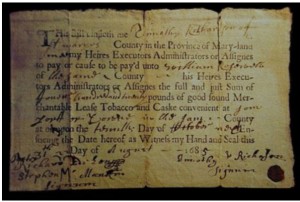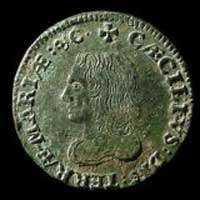Calvert Penny
A Penny Saved
T hroughout the 17th century Maryland had few coins in circulation. Some English and other coins were used but the primary medium of exchange was tobacco, the principal product of the province. From the earliest days of the colony, tobacco was accepted as legal tender. This is not to suggest that people carried casks of tobacco with them to pay bills. Instead, a complex system of promissory notes served the currency exchange needs. Early Maryland basically had a paper economy of credits and debts which rivals our current economy of credit and debit cards.
hroughout the 17th century Maryland had few coins in circulation. Some English and other coins were used but the primary medium of exchange was tobacco, the principal product of the province. From the earliest days of the colony, tobacco was accepted as legal tender. This is not to suggest that people carried casks of tobacco with them to pay bills. Instead, a complex system of promissory notes served the currency exchange needs. Early Maryland basically had a paper economy of credits and debts which rivals our current economy of credit and debit cards.
Cecil Calvert, the Lord Baltimore, wished to improve the situation by introducing his own coinage in the 1659. The Calvert coinage consisted of four denominations in two metals. The shilling (12p), the sixpence (6p), and the groat (4p) were minted in silver while the Denarium or penny (1p) was struck in a copper alloy. Lord Baltimore’s effort was short-lived and unsuccessful. His right to mint coins was called into question in England and the production was insufficient to make any impact on the Maryland economy. Tobacco was the exchange medium and continued to dominate throughout the colonial period.
 |
 |
Coins of any kind were extremely rare in 17th century Maryland. In fact, specie coins were so rare that the colony declared tobacco as the legal tender of the colony. Rather than calculate prices and debts in pounds sterling, pounds of tobacco were the means of exchange. We don’t suggest that people carried tobacco around with them the way we do money today. Instead, almost everything was done with credit and tobacco promissory notes which circulated much like our modern currency. The economy and riches existed primarily on paper. Although Lord Baltimore tried to introduce his own coinage in 1659 and there was legislation to establish a mint in 1661, it appears to have been no great success. Instead, the colony continued to be based on tobacco – the source of all wealth and the medium of exchange.
 |
 |
The Calvert penny is struck in a copper alloy and bears on one face (the obverse) the left-facing bust of Cecil Calvert while the reverse bears the palatine coronet (crown) with two pendants. The legends are all in abbreviated Latin with the obverse CAECILVS : DNS : TERRAE-MARIAE:&CT (Cecil, Lord of Maryland etc.) and the reverse +DENARIVM: TERRAE-MARIAE (penny of Maryland).
Historic St. Mary’s City has had the good fortune to arrange the loan of an example of the Calvert coinage from the St. Mary’s County Historical Society. The specimen has a long St. Mary’s County provenance. The Calvert penny is on exhibit at the Visitor Center. We thank the Historical Society for its kindness in extending the loan of the Calvert penny so that we can share it with our visitors.


